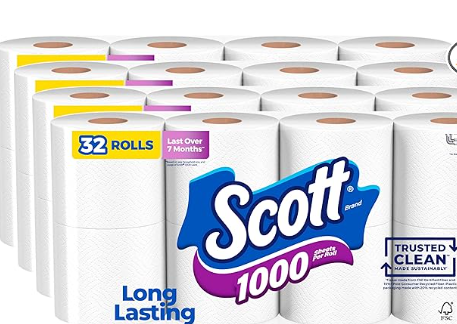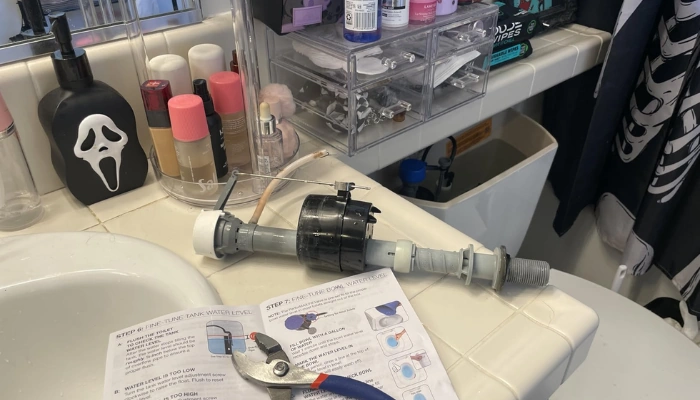Limescale buildup in the toilet is a common household problem, especially in areas with hard water. It often appears as white, chalky deposits or brownish stains around the bowl, under the rim, or near the waterline. While it may look unpleasant, limescale can also affect flushing performance and make cleaning more difficult over time. This guide explains exactly what causes limescale in toilets, why it keeps coming back, and what you can do to prevent and manage it effectively.

MSVVKO Limescale Cleaner: Formulated for tackling tough mineral deposits, this limescale cleaner is designed for users dealing with visible calcium buildup. It suits bathrooms and kitchens where hard water stains are common and manual scrubbing alone is not enough. The cleaner focuses on breaking down scale to make removal easier.
Check PriceUnderstanding Limescale and How It Forms
Limescale is a mineral residue left behind when hard water evaporates. Hard water contains high levels of dissolved minerals, mainly calcium and magnesium. When toilet water sits in the bowl or flows repeatedly through the same areas, these minerals slowly settle and harden into visible deposits.
Unlike dirt or grime, limescale is not caused by poor cleaning habits. Even well maintained toilets can develop limescale if the water supply contains a high mineral content.
The Main Causes of Limescale in Toilets
Hard Water Supply
The most common cause of limescale in toilets is hard water. Areas with naturally high mineral levels in their water supply experience faster and heavier limescale buildup. Every flush leaves behind tiny mineral traces that gradually accumulate.
Standing Water in the Toilet Bowl
Water that remains in the toilet bowl for long periods allows minerals to settle. Toilets that are rarely used often develop more limescale because the water does not circulate frequently enough to reduce mineral deposits.
Slow or Weak Flush
A weak flush may not fully rinse the bowl and rim, allowing minerals to cling to surfaces. Over time, this leads to thicker and more stubborn limescale buildup, especially under the rim where water flow is limited.
Leaking Toilet Components
A leaking flapper or fill valve can cause a constant trickle of water into the bowl. This steady flow increases mineral exposure and speeds up limescale formation, often creating streaks or heavy deposits near the waterline.
Porcelain Surface Wear
Older toilets or damaged porcelain surfaces are more prone to limescale. Tiny scratches and rough areas give minerals more places to attach and harden, making buildup harder to remove.
Where Limescale Commonly Appears in Toilets
Limescale does not form evenly across the toilet. Certain areas are more vulnerable due to water flow and exposure.
Under the rim is one of the most common locations, as water flows slowly and minerals settle unnoticed.
The waterline area often shows visible rings caused by repeated evaporation.
Jet holes can clog with limescale, reducing flush power.
The bottom of the bowl may develop thick deposits in toilets with low water movement.
Why Limescale Keeps Coming Back
Even after thorough cleaning, limescale often returns. This happens because the root cause, hard water, remains unchanged. Each flush introduces fresh minerals, restarting the buildup process. Without preventive steps, cleaning only removes existing deposits rather than stopping new ones from forming.
Is Limescale Harmful
Limescale itself is not harmful to health, but it can cause practical issues. Heavy buildup can restrict water flow, weaken flushing performance, and lead to unpleasant odors by trapping bacteria. Over time, it may also shorten the lifespan of toilet components by causing wear and blockages.
How Limescale Affects Toilet Performance
As limescale accumulates, it can block rim holes and siphon jets, reducing flushing efficiency. This often leads to multiple flushes, increased water use, and higher utility bills. In severe cases, internal parts may require repair or replacement.
How to Prevent Limescale in Toilets
Regular Cleaning
Frequent light cleaning prevents minerals from hardening into thick deposits. Cleaning the bowl and under the rim weekly can significantly slow buildup.
Improve Flush Efficiency
Ensuring the toilet flushes properly helps rinse away minerals before they settle. Fixing leaks and maintaining internal components makes a noticeable difference.
Reduce Standing Water
In guest bathrooms or rarely used toilets, flushing occasionally helps refresh the water and limit mineral settling.
Water Softening Solutions
Installing a whole house water softener or localized treatment can reduce mineral content in the water supply. This is one of the most effective long term solutions in hard water areas.
Products That Help Manage Limescale
While this guide focuses on causes, many homeowners look for tools that make cleaning easier. Toilet brushes designed to reach under the rim, silicone brushes that resist buildup, and cleaner holders that dry quickly can all help manage limescale more effectively. Products that improve hygiene and reduce moisture can support ongoing maintenance but should be paired with regular cleaning habits.
1. Limescale Cleaning Brushes Set

Limescale Cleaning Brushes Set: Designed for tackling stubborn mineral buildup, this limescale cleaning brush set is suitable for homeowners who prefer manual, chemical free cleaning. It works well on toilets, sinks, taps, and other bathroom surfaces where calcium deposits build up over time. The brushes offer controlled scrubbing and are especially useful for reaching tight corners and edges.
Check PriceKey Features
• Multiple brush sizes for different areas
• Firm bristles for limescale removal
• Suitable for bathroom and kitchen use
• Reusable and easy to rinse
• Lightweight and easy to handle
Pros
• No chemicals required
• Good control for detailed cleaning
• Versatile household use
Cons
• Requires physical effort
• Not effective on very thick buildup alone
Filan Verdicet
This brush set is a practical choice for users who prefer hands on cleaning and want an eco friendly way to manage limescale. It works best for light to moderate deposits and routine maintenance rather than heavy scale that has built up over years. The variety of brush sizes makes it flexible for different surfaces, from toilet rims to faucet edges. While it does require some scrubbing effort, it gives users precise control and can be combined with cleaning solutions for better results.
2. Scrubbing Bubbles Fresh Gel Toilet Clean and Helps Prevent Limescale

Scrubbing Bubbles Fresh Gel Toilet: Made for users who want continuous toilet freshness and reduced limescale buildup, this toilet cleaning gel is applied directly inside the bowl. It is ideal for busy households that want ongoing maintenance without frequent scrubbing. The gel releases cleaner with each flush to help slow mineral and stain buildup.
Check PriceKey Features
• Flush activated cleaning gel
• Helps reduce limescale and stains
• No cage or hanging device
• Easy application inside bowl
• Long lasting use per stamp
Pros
• Low maintenance solution
• Keeps bowl cleaner between scrubs
• Simple to apply
Cons
• Does not remove heavy buildup
• Requires reapplication over time
Filan Verdicet
This product works best as a preventive solution rather than a deep cleaner. It helps slow down limescale formation and keeps the toilet fresher between regular cleanings. Users with hard water may still need periodic scrubbing, but the gel stamps reduce how often that is necessary. It is well suited for families or anyone looking to reduce cleaning frequency while maintaining a cleaner looking bowl.
3. MSVVKO Toilet Bowl Limescale Cleaner

MSVVKO Limescale Cleaner: Formulated for tackling tough mineral deposits, this limescale cleaner is designed for users dealing with visible calcium buildup. It suits bathrooms and kitchens where hard water stains are common and manual scrubbing alone is not enough. The cleaner focuses on breaking down scale to make removal easier.
Check PriceKey Features
• Targets calcium and limescale
• Suitable for toilets and sinks
• Liquid formula for surface coverage
• Works on hard water stains
• Designed for deep cleaning
Pros
• Effective on stubborn buildup
• Reduces scrubbing effort
• Useful for multiple surfaces
Cons
• Requires careful handling
• Not intended for daily use
Filan Verdicet
This cleaner is best for users facing noticeable limescale problems that routine cleaning cannot manage. It works well as a periodic deep cleaning solution to restore surfaces affected by hard water. While it should be used carefully and not too frequently, it can significantly improve results when dealing with heavy mineral deposits. It pairs well with regular maintenance tools to keep buildup under control long term.
4. Viakal Limescale Spray 500ml

Viakal Limescale Spray: Designed for regular household use, this limescale spray is suitable for people who want a simple solution for hard water stains. It works on bathroom surfaces like toilets, sinks, and fixtures, making it a versatile option for ongoing maintenance. The spray format allows easy application on vertical and curved surfaces.
Check PriceKey Features
• Spray application for convenience
• Targets limescale and water spots
• Suitable for bathroom surfaces
• Easy to wipe off
• Helps restore surface appearance
Pros
• Simple to use
• Good for routine cleaning
• Works on multiple surfaces
Cons
• Less effective on thick buildup
• Requires repeated use in hard water areas
Filan Verdicet
This limescale spray is a good option for maintaining cleanliness and preventing buildup rather than removing severe deposits. It works best when used regularly as part of a cleaning routine. Users in hard water areas will still need occasional deeper cleaning, but this spray helps keep surfaces looking cleaner and reduces visible scale over time. It is well suited for everyday bathroom maintenance and ease of use.
Common Myths About Toilet Limescale
Some people believe limescale only appears in dirty toilets, which is not true. Others assume it can be permanently eliminated with one deep clean. In reality, limescale is an ongoing issue tied to water quality rather than cleanliness alone.
FAQs About What Causes Limescale in Toilets
What causes brown limescale stains in toilets?
Brown stains usually occur when limescale mixes with iron or other minerals in the water. These stains are common in older plumbing systems.
Why does limescale form under the toilet rim?
Water flows slowly under the rim, allowing minerals to settle and harden unnoticed. This area is often missed during routine cleaning.
Can soft water prevent limescale completely?
Soft water greatly reduces limescale but may not eliminate it entirely. Small amounts can still form over time, especially in standing water.
Does limescale mean my toilet is damaged?
No, limescale does not indicate damage. However, heavy buildup can eventually affect performance if left untreated.
How fast does limescale build up in a toilet?
The speed depends on water hardness, toilet usage, and maintenance. In very hard water areas, buildup can appear within weeks.
Final Verdict
Limescale in toilets is primarily caused by hard water, standing water, and mineral rich flushing systems. While it is not harmful, it can impact toilet performance, appearance, and maintenance effort over time. Understanding why limescale forms makes it easier to manage and prevent. Regular cleaning, proper toilet maintenance, and addressing water hardness are the most effective ways to keep buildup under control. With the right approach, limescale becomes a manageable issue rather than a constant frustration.



